Maharajas, Myths and Mysteries: The Fascinating History of India’s Jewels and Jewellery
Along with the local legends and historical chronicles, the jewels and jewellery that have survived from different periods and different parts of India provide evidence of an ornament making tradition without parallel in the world.
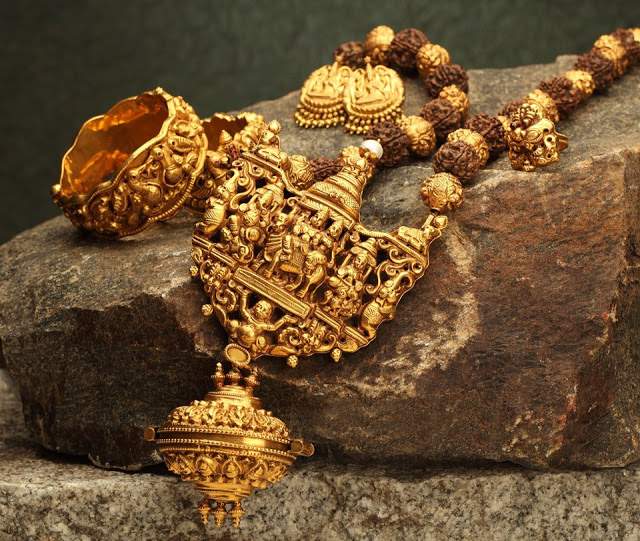
Spanning a legacy of 5,000 years, the jewellery of India is a striking expression of the country’s aesthetic and cultural history. The small number of jewels that have survived from different periods and different parts of the country, references in literature, texts on gemology, myths, legends and chronicles provide evidence of a tradition without parallel in the world.
The history of jewellery in India is, to a large extent, the history of the country itself.
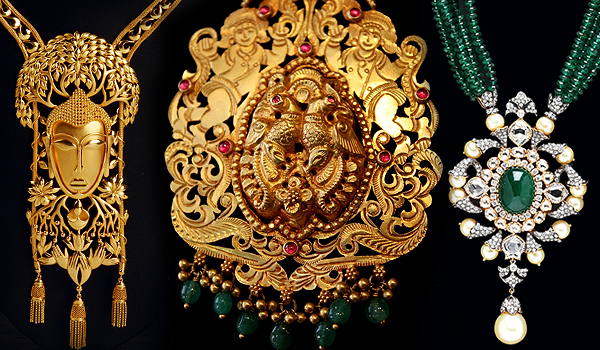
Photo Source
For more than 2,000 years, India was the sole supplier of gemstones to the world. Golconda diamonds, sapphires from Kashmir and pearls from the Gulf of Mannar were coveted and drew merchants across land and sea to India. For the rulers, jewels were a statement of power, prosperity and prestige. But for Indian women, jewellery was, and is, in many parts considered a social and economic security, the value of which will almost always appreciate, never depreciate.
The story of India’s fascination with jewellery begins 5,000 years ago in the Indus Valley.
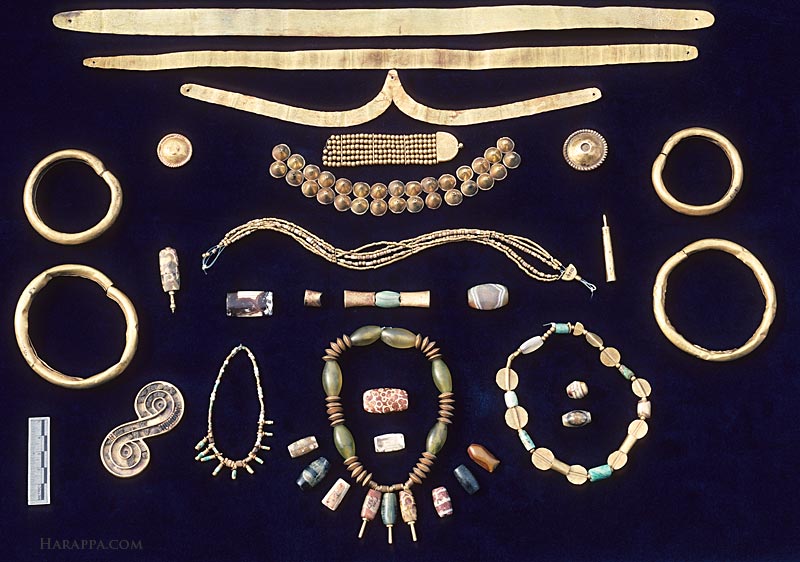
Photo Source
At that time, India was the largest manufacturer and exporter of beads to the world. India was also home to the diamond and invented the diamond drill, which was then taught to the Romans.The craftsmen of the Indus Valley Civilisation used semi-precious material like carnelian, agate, turquoise, faience, steatite and feldspar, fashioning them into tubular or barrel shapes, decorating them with carvings, bands, dots and patterns, or setting them minutely with gold.
Going by the jewellery they made and wore, the ancient people of the Indus Valley Civilisation were an extremely sophisticated lot with a finely developed aesthetic sense, backed by intricate engineering skills. Take for instance the necklace excavated from Mohenjodaro now on display at the jewellery gallery of the National Museum in Delhi.
The necklace, dating back nearly 5,000 years, is lined with pendants of banded agate and jade beads suspended by a thick gold wire that passes through a perfectly drilled hole in each bead.
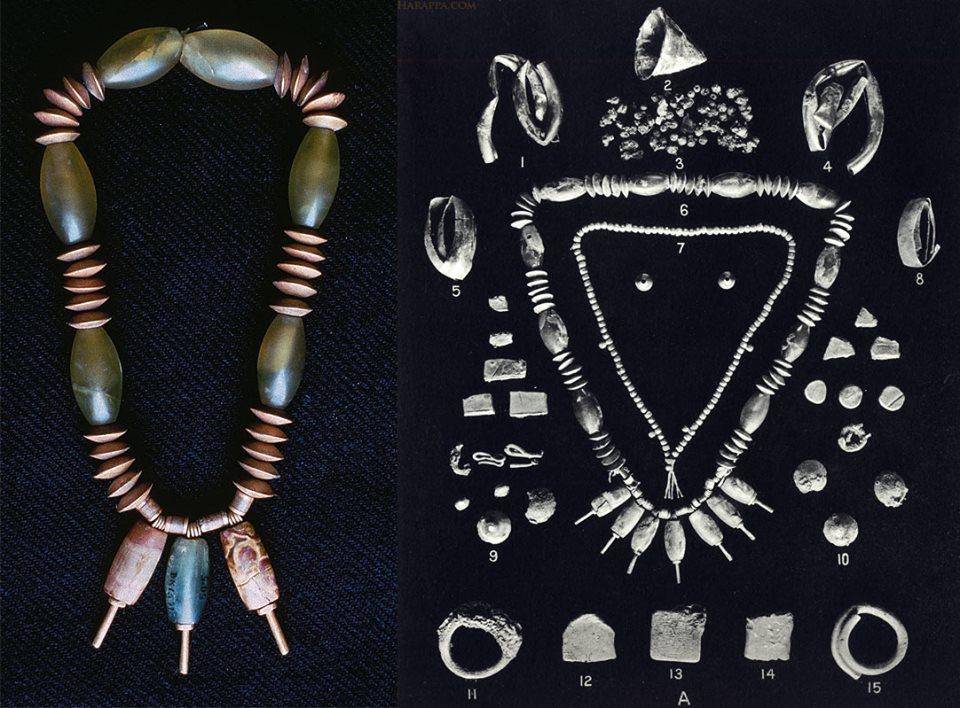
Photo Source
But it’s not just technological prowess that one marvels at. What’s also remarkable is the continuity of design. The sheet gold forehead ornament, for instance, is of a shape that you will find women still wearing in different parts of India. The Rajasthani borla is a close approximation, as is the ornament that Didarganj Yakshi, one of the finest examples of ancient Indian sculpture, wears prominently in the middle of her forehead.
Yet despite the relative simplicity of these early pieces, Indian jewellery was about to become much more complex in its style and workmanship. In the 2,000 years after the decline of Mohenjodaro, the Indian craftsman had polished his skills immensely. So there’s delicate filigree work on gold, embossing work and detailed micro-granulations on the pendants of a pair of large earrings that date back to this period.
Also Read: 16 Fascinating Facts about Mohenjodaro and Indus Valley, a Civilisation Far Ahead of its Time
The sculptures at Bharhut, Sanchi and Amaravati and the paintings at Ajanta depict a wide range of jewellery worn by man and woman, by king and commoner.While Silappadikaram, an ancient Tamil classic of the Sangam era, talks of a society dealing in gold, pearls and precious stones, the chronicles of Paes, a Portuguese traveller, describes the dazzling jewellery worn by the people of the Vijayanagar empire.
The temples of south India, central India, Bengal and Odisha too were home to a veritable cornucopia of the jeweller’s art.

Photo Source
Initially, these intricate pieces were crafted solely with the purpose of adorning the idol. However, with the passage of time, dancers who regaled audiences at the temple with their renditions of devotional pieces began to wear imitations of the jewellery style adopted for the idols. Along with the spread of Bharatnatyam, temple jewellery became an accessible style and soon made its way into the world of trousseau and heirloom pieces.
Temple jewellery is generally large and chunky, with figures of various gods and goddesses in gold fused to or forming the pendant on pearl string necklaces. Shiny rubies and emeralds are set in these pieces in attractive patterns that catch the eye while some pendants also resemble the ‘gopuram’ or temple entrance towers in design. Representative pieces of this sort signified the wearer’s special relationship with gods and the mythic universe.
This supernatural potency ascribed to jewelry is exemplified by the navaratna, an amulet or necklace set with nine types of precious stones, which together symbolize the nine gods of the Hindu universe.
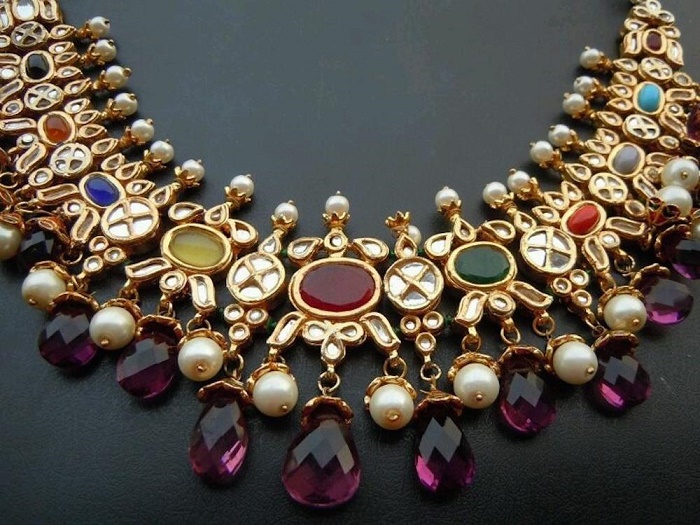
Photo Source
The advent of Mughal rule further embellished the world of Indian jewellery. The fusion of Indian and Central Asian styles and patterns resulted in a great outburst of ornamentation, elegant and exquisite, and of a lush extravagance never seen before. Although traces of enamelling in jewellery (the reverse side of each jewel is covered with intricate enamel work) have been found at the ancient town of Taxila, this technique reached its zenith only under the Mughals.
In fact, Mughal patronage provided the platform for the development of existing traditions in jewellery making, as well as the creation of innovative techniques.

Photo Source
Ancient Indian designs were gently modified to incorporate various geometrical, floral and nature-inspired designs. The combination of crescent and stem – earrings had a small stem at the top of a crescent from which a fish was suspended, and further led to a bunch of pearls – became a regular feature of Mughal jewellery.
The kundan method of setting stones in pure gold was also perfected by artisans in the Mughal period. Here, the gold used for jewellery was fused at room temperature. Another technique that was developed by the Mughals was the inlaying of stones with gold.
Precious metals with hammered relief decoration and enamelling, the incrustation of jade with patterns, with stem-work of gold and leaves and flowers in stones, were techniques that produced a treasure of designs.
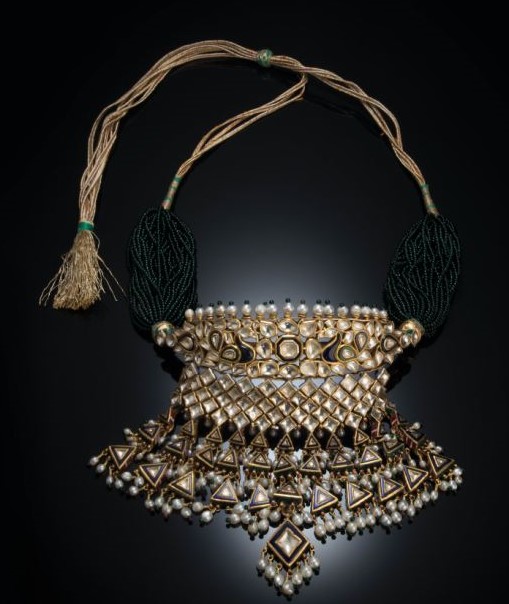
Photo Source
The repetitive colour palette of green, red and white in Mughal designs corresponds to the intensive use of emeralds, rubies and diamonds. As much as these gems were a symbol of the opulence and dignity of the empire, they were also treasured as protective talismans. Emeralds were enormously popular with the Mughal Court, whose emperors referred to them as “Tears of the Moon.”
One of the most treasured jewels in Indian history, the Taj Mahal Emerald, is an exquisite hexagonal emerald intricately carved with stylised flowers that mirror the decor of the Taj Mahal.
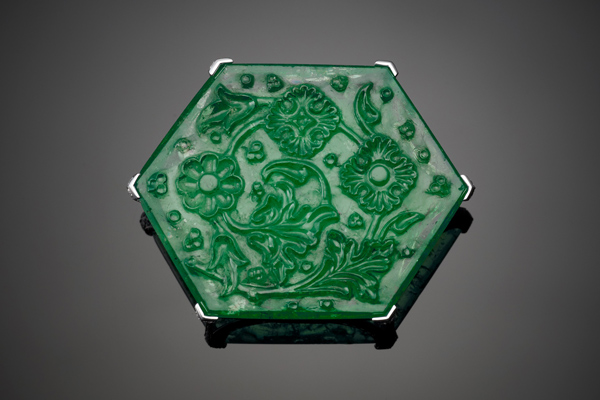
Photo Source
The Jadau technique is believed to have been brought to India by the Mughals but Indian artisans of Rajasthan and Gujarat perfected the craft and added their unique touches to make it their own. The process of Jadau-making involves beating or heating pure gold until it is pliable, creating a frame and motif, filling lac in the hollow frame and setting precious stones in the appropriate spaces.
Once the stones are set, using only heated gold and no other adhesive, the jeweller proceeds with the meenakari work, patiently working on the piece one colour at a time. This time-consuming process results in a stunning piece of jewellery that was, and still is, fit for kings. The much-loved Karanphool Jhumka also evolved during this period, with each region having its own special embellishment added to the basic flower-shaped ear ornament.
The Asaf Jahi Nizams of Hyderabad were also famed for their legendary jewels. The last Nizam, Mir Osman Ali Khan (once called the richest man in the world by the TIME magazine), had an unbelievable collection of jewels.
He gifted the stunning Nizam of Hyderabad diamond necklace to Queen Elizabeth II when she married Prince Philip.

Photo Source
The Rockefeller Sapphire, a Burmese blue sapphire of 62.02 carats, also belonged to the Nizam of Hyderabad before it was acquired by John D. Rockefeller in 1934. Then there is the Jacob Diamond, the enormous diamond that was apparently used as a paperweight by Mir Osman Ali Khan after he found it inside his father’s slipper.
Also among the Nizams’ jewels are fabulous head decorations, known as aigrette or sarpech, from the word sar for head and pech for screw. Veritably dripping with fine gemstone drops, the sarpech was worn by the Nizams as a turban ornament. Just one of these contained more gemstones than most people could afford to acquire in an entire lifetime.
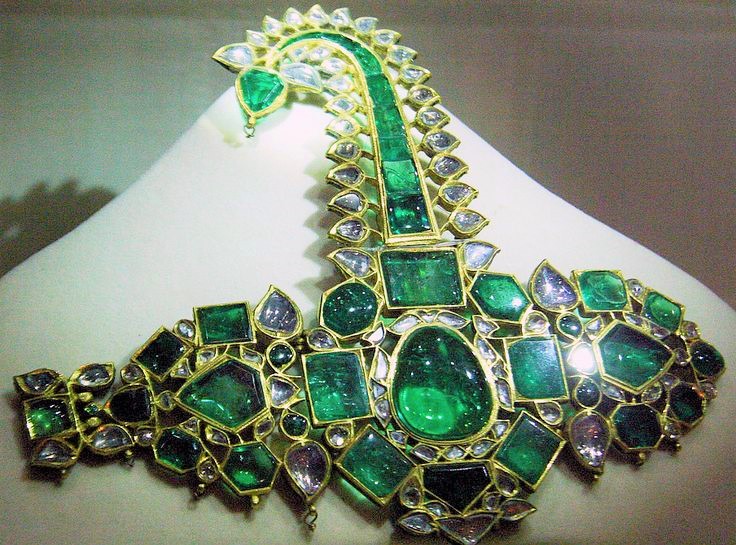
Photo Source
Other remarkable pieces in the Nizams’ collection include a seven-strand pearl necklace, known as satlada (meaning seven strings), which contains approximately 465 Basra pearls. The pearls are from the city of Basra, in modern-day Iraq. Pearls from this region have been treasured for hundreds of years, for their perfectly spherical shape, silvery-white color and beautiful iridescence. There is also the paizeb, anklets made from hinged gold panels studded with gemstones that were worn by the women of the royal court of the Nizams.
You May Like: 14 Fascinating and Perplexing Unsolved Mysteries of Indian History
During the late 19th and early 20th centuries, Indian jewellery design began to absorb influences from the country’s colonial rulers. Design evolved and the cultural narrative became yet more complex, as renowned European jewellers like Cartier began to create pieces for the maharajahs, setting Indian stones in India-influenced pieces made in Paris.
Cross-cultural influence worked the other way too: Cartier’s famous “tutti frutti” style was based on the floral motifs of South Indian jewellery, complete with sapphires, emeralds and rubies.
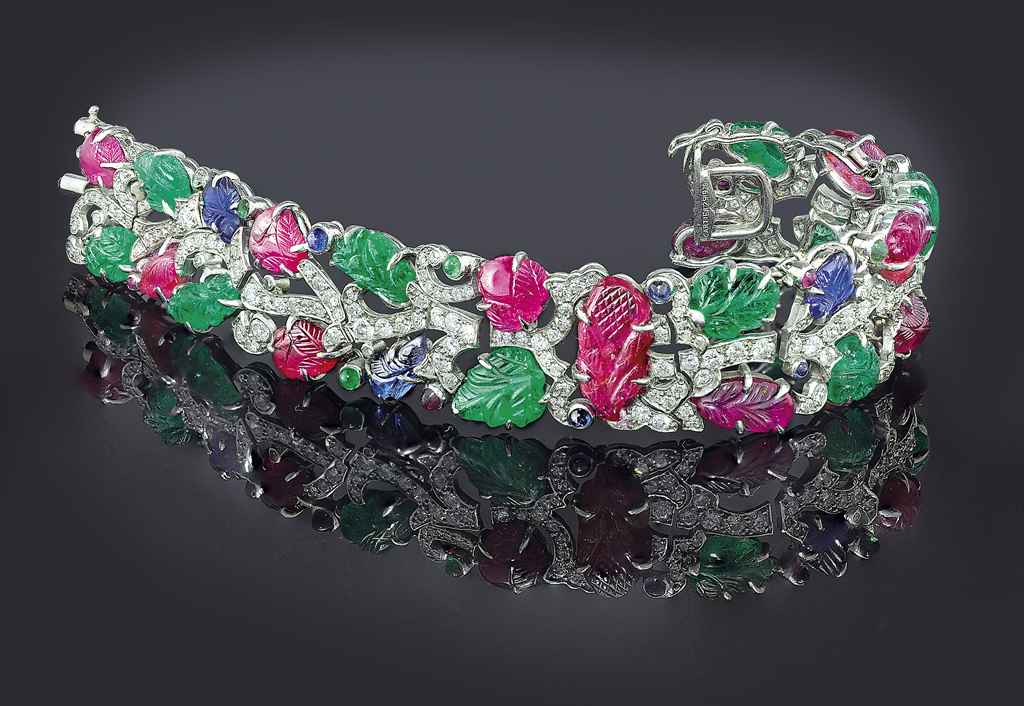
Photo Source
The story of Indian jewellery is incomplete without a mention of two of the most famous gems in the world – the Kohinoor and the Hope Diamond.
Entrenched in history, having been passed down by some of the greatest rulers of massive empires in the Indian subcontinent, the Kohinoor is a priceless diamond the size of a ping pong ball. According to legends, in the 13th century, the diamond was found in Guntur, in Andhra Pradesh. Currently housed in the Tower of London in the United Kingdom, the diamond’s ownership has been much disputed by four countries – India, Pakistan, Afghanistan and Britain. Read more about its journey here.
One of the most spectacular gems in the world, the Hope Diamond is a lustrous blue gem weighing 45.52 carats. The largest blue diamond in the world, the gem is rumoured to be a cursed stone that brings ill luck to its owner. The stone was discovered in India and is believed to have been plucked from a sculpted statue of a goddess in a temple. In 1668, King Louis XIV of France bought it from a french traveller before re-cutting it several times to the gem that today adorns a chain of 45 white diamonds, surrounded by 16 alternating pear-shaped and cushion-cut white diamonds.

Photo Source
To know more about Indian jewels and the fascinating stories behind them, visit the Alamkara gallery of the National Museum in Delhi. It has the most extensive collection of jewellery in India. From the beautifully tumbled agate bead necklaces of Mohenjodaro and Harappa to the fabulous jewels adorned with images of gods and goddesses to the magnificent items that once reposed in the treasuries of the Mughal emperors and the maharajas, the collection spans all the important periods in Indian history.
A grassroots social enterprise in Maharashtra, NGO Seema Circle empowers underprivileged women from local villages through jewelry making, educational opportunities, and community collaboration. Featuring jewelry made from meticulous paper work, semi-precious stones, Swarovski crystals, and sterling silver components, the handcrafted collection is sold to an international market with all of the profits devoted to the artisans.
To contact Seema Circle, click here.
Like this story? Have something to share? Email: contact@thebetterindia.
NEW! Log into www.gettbi.com to get positive news on WhatsApp.

Similar Story

Kyani to Nirula’s: Artist Takes India Down Memory Lane with Sketches of Iconic Eateries
Aditya Raj from Jaipur visited an exhibition during his law school days and decided he would be an artist. Here’s his visual representation of a nostalgia trip with pictures of the most iconic eateries in India.
Read more >
If you found our stories insightful, informative, or even just enjoyable, we invite you to consider making a voluntary payment to support the work we do at The Better India. Your contribution helps us continue producing quality content that educates, inspires, and drives positive change.
Choose one of the payment options below for your contribution-
By paying for the stories you value, you directly contribute to sustaining our efforts focused on making a difference in the world. Together, let's ensure that impactful stories continue to be told and shared, enriching lives and communities alike.
Thank you for your support. Here are some frequently asked questions you might find helpful to know why you are contributing?


This story made me
-
97
-
121
-
89
-
167












